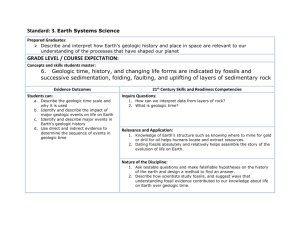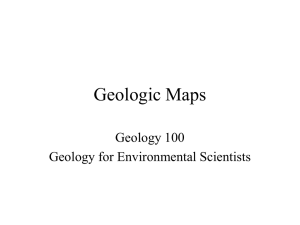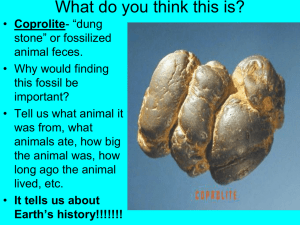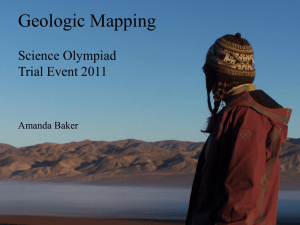Geology as a Way of Knowing and the
advertisement
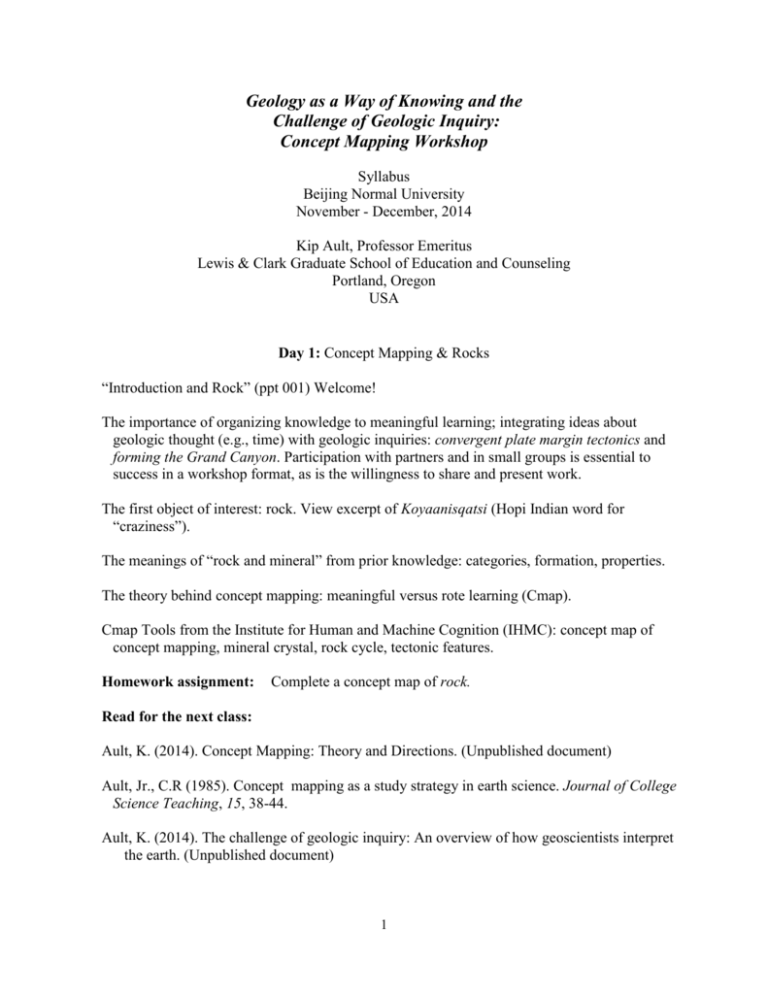
Geology as a Way of Knowing and the Challenge of Geologic Inquiry: Concept Mapping Workshop Syllabus Beijing Normal University November - December, 2014 Kip Ault, Professor Emeritus Lewis & Clark Graduate School of Education and Counseling Portland, Oregon USA Day 1: Concept Mapping & Rocks “Introduction and Rock” (ppt 001) Welcome! The importance of organizing knowledge to meaningful learning; integrating ideas about geologic thought (e.g., time) with geologic inquiries: convergent plate margin tectonics and forming the Grand Canyon. Participation with partners and in small groups is essential to success in a workshop format, as is the willingness to share and present work. The first object of interest: rock. View excerpt of Koyaanisqatsi (Hopi Indian word for “craziness”). The meanings of “rock and mineral” from prior knowledge: categories, formation, properties. The theory behind concept mapping: meaningful versus rote learning (Cmap). Cmap Tools from the Institute for Human and Machine Cognition (IHMC): concept map of concept mapping, mineral crystal, rock cycle, tectonic features. Homework assignment: Complete a concept map of rock. Read for the next class: Ault, K. (2014). Concept Mapping: Theory and Directions. (Unpublished document) Ault, Jr., C.R (1985). Concept mapping as a study strategy in earth science. Journal of College Science Teaching, 15, 38-44. Ault, K. (2014). The challenge of geologic inquiry: An overview of how geoscientists interpret the earth. (Unpublished document) 1 Ault, C.R., Jr. (1998). Criteria of excellence for geological inquiry: The necessity of ambiguity: Journal of Research in Science Teaching, 35, 189-212. Cleland, C.E. Common cause explanation and the search for the smoking gun. In V.R. Baker (Ed.), Rethinking the fabric of geology (pp. 1-9). Geological Society of America Special Paper 502. doi: 10.1130/2013.2502(01) Frodeman, R. (1995). Geological reasoning as an interpretive and historical science. Geological Society of America Bulletin, 107, 960-968. Day 2: Geological Reasoning “Criteria of Excellence for Geological Inquiry: The Necessity of Ambiguity” (ppt 004). “Geologic Explanation and the Smoking Gun” (ppt 008) In class exercise: working in pairs, construct a preliminary concept map of geological reasoning. Homework assignment: Complete a concept map of geological reasoning. Read for the next class: Anderson, D.L. (2006). Plate tectonics; the general theory: Complex Earth is simpler than you think. In C.A. Manduca & D.W. Mogk (Eds.), Earth and mind: How geologists think and learn about the earth (pp. 29-38). Geological Society of America Special Paper 413, Boulder, CO: GSA. doi: 10.1130/2006.2413(03) Day 3: Convergent Plate Margins “Tectonic Plates and Earthquakes in Cascadia” (ppt 003) In small groups, begin working on a concept map of convergent plate margin tectonics based on the information learned about tectonic plates and earthquakes. (“Tectonics” refers to the processes that structure the earth.) Homework assignment: Continue work on convergent plate margin tectonics concept map. Read for the next class: Ault, C.R., Jr. Review of The Orphan Tsunami of 1700. [Recommended reading for more background on tsunamis in the Pacific NW: Atwater, B.F., et al. (2005). The orphan tsunami of 1700—Japanese clues to a parent earthquake in North America. U.S. Geological Survey Professional Paper 1707. http://pubs.usgs.gov/pp/pp1707/pp1707.pdf 2 Ault, K. (2014). The ghost forests of Cascadia: How valuing geological inquiry puts practice into place. Journal of Geoscience Education, 62, 158-165. Abridged version. Oregon State University research news on turbidite evidence for tsunami hazards and subduction zone earthquakes in Cascadia: Goldfinger, C., et al. (2012). Abstract and introduction (from the instructor) for: Turbidite event history—methods and implications for Holocene paleoseismicity of the Cascadia Subduction Zone. U.S. Geological Survey Professional Paper 1661-F. http://pubs.usgs.gov/pp/pp1661f/ http://oregonstate.edu/ua/ncs/archives/2012/jul/13-year-cascadia-study-complete%E2%80%93-and-earthquake-risk-looms-large http://activetectonics.coas.oregonstate.edu/cascadia_turbs.htm Day 4: “Orphan” Tsunami “The Orphan Tsunami Story” (ppt 005) Peer editing of concept maps on convergent plate margin tectonics: add turbidites and tsunamis. Homework assignment: Complete convergent plate margin tectonics concept map. Read for the next class: Ault, K. (2014). The Grasp of Geologic Time. Read 1 of the following three articles, as assigned, for the next class: Karlstrom, K., et al. (2012). Introduction: CRevolution 2: Origin and evolution of the Colorado River system II. Geosphere, 8, 1170–1176. doi:10.1130/GES00716.1 Pederson, J. L. (2007). The mystery of the pre–Grand Canyon Colorado River—Results from the Muddy Creek Formation: GSA Today, v. 183, p. 4-10. doi: 10.1130/GSAT01803A.1 Lucchita, I., Holm, R.F., & Lucchitta, B.K. (2013). Implications of the Miocene (?) Crooked Ridge River of northern Arizona for the evolution of the Colorado River and Grand Canyon. Geosphere, 9, 1417–1433. doi:10.1130/GES00861.1 Day 5: The Grand Canyon of the Colorado River “Grand Canyon” (ppt 006) and “Deep Respect for the Present Moment” (poem). In class preparation in teams of 3 of a concept map on forming the Grand Canyon. Each member of the team will have read a different article. “Geologic Time” (ppt 007) 3 Homework assignment: Complete the forming the Grand Canyon concept map by adding concepts about geological reasoning and geologic time. Be prepared to present the completed map. Read for the next class: Romey, William D. (1983). Winter ice and snow as models of igneous rock formation, Journal of Geological Education, 31, 9-12. Day 6: Thinking like a Geologist Presentations of forming the Grand Canyon concept maps integrated with concepts about geological reasoning and geologic time. “Snow and Ice as Sediment and Rock?” (ppt 002) Analogy in geological thought: working in pairs, make a concept map of one of the sections in the article about snow and ice as models of rock formation by W.D. Romey. 4 The Challenge of Geologic Inquiry: An Overview of How Geoscientists Interpret the Earth Kip Ault November 17, 2014 “Knowledge is not absolute, but rather it is dependent upon the concepts, theories, and methodologies by which we view the world.” --D. Bob Gowin & Marino C. Alvarez, The Art of Educating with V Diagrams (2005) Geologic inquiry depends upon concepts and practices responsive to the challenge of interpreting the earth—to connecting the patterns of its landscapes and structures to the processes that formed them. Dynamic interactions encompassing both physical and living systems span the vastness of geologic time and occur from micro to macro scales in time and place. Understanding “scale” is crucial to geology as a way of knowing. Geologic problems cross many scales and at each scale solutions may differ. Yet these solutions must cohere—the explanation patterns of crystal formation must not contradict the account of regional crustal movements, for example, when interpreting a particular place on earth. The present contains remnants of the past distributed as confusing puzzles. Geoscientists strive to solve these puzzles with methods of inquiry adapted to this end. Often unable to execute experimental methods, geologic inquiry stands as emblematic of diversity among scientific ways of knowing. Geology values comparing ancient landscapes to modern analogs, substituting place for time, determining temporal relationships, and entertaining multiple working hypotheses. Confidence in geologic solutions increases when independent lines of evidence converge on the same explanation and solutions to problems on different scales cohere. Temporal reasoning permeates the task of interpreting the earth’s history and structure. Many of the important concepts in geology encapsulate a time series: its key words imply stories. Consider “eruption” and “erosion” for example. Each of these concepts refers to a process that unfolds in time. Geologic rhetoric is temporal rhetoric. Eruption and erosion happen as a sequence of events. Disciplinary practices diversify as they respond appropriately to the nature of different challenges, such as time’s vastness. In geological inquiry, place by place comparisons converge on past causes and future risks, an approach irreducible to single variable manipulation in a controlled experiment. When traces of past events carefully sequenced and synchronized create a set of anomalous associations across time and place, a geologist seeks a common cause rendering these anomalous associations plausible. Geoscientists often represent temporal relationships visually, depicting data in forms that promote spatial reasoning. Geologic maps are the perfect—and stunningly attractive—example. They color time. Good geologic reasoning depends upon making comparisons in terms of carefully restrained, yet ultimately ambiguous, categories. The reason is simple: every feature of the earth has a history. All “deltas” are similar to each other and at the same time each one is unique. The same observation applies to “mountains” and “faults” and even “crustal plates.” These are the objects of interest in geology. Productive comparisons among deltas and between deltas and seafloor fans yield insights into the processes that formed them—and inferring processes from 5 patterns is the goal of geologic inquiry. In contrast, individual atoms of carbon 12 are utterly indistinguishable and completely interchangeable. A carbon atom does not come wrapped in the history of its past interactions; the Grand Canyon of the Colorado River does. How this river may have exited the Colorado Plateau has fueled contentious debate for many years. Perhaps for a time the river simply faded away without reaching the ocean. Some propose that the Colorado infiltrated Paleozoic limestones beneath its riverbed, dissolved masses of carbonate rock, and emerged in desert springs only to evaporate, re-depositing volumes of limestone. Comparison to how major rivers terminate in China’s Tarim Basin and Angola’s Kalahari Desert give credence to this interpretation of one of the earth’s most striking and dynamic features. Through this mini-course, as you learn to depict your understanding of geologic phenomena with concept maps, your grasp of geologic inquiry will grow. Keep in mind the important match between conceptions of geologic phenomena to practices characteristic of geologic inquiry. The match responds to the distinctive challenge of time’s vastness. Keep in mind that developing a sense of scale is a distinctive feature of learning geoscience. The concept of scale functions both psychologically and epistemologically. Psychologically, scale may present obstacles to perception and insight. Epistemologically, extrapolation of earth processes in time and space is a goal of explanation. The geologic time scale encompasses durations and changes vastly beyond the scale of human lifetimes; forecasts of global climate change must wrestle with problems of sampling and modeling on various scales. Geologic inquiry has distinctive features such as: 1. The historical approach, pioneered by Charles Lyell and Charles Darwin, to scientific inquiry (e.g., Darwin’s account of the reefs around coral atolls of the Pacific: the islands as a sampling distribution across space and through time of what happens to a volcanic island as it rises and subsides over immense, unwitnessed durations). 2. The concern for complex systems acting over the earth as whole (e.g., the several “spheres”: hydro, geo, atmos, and their interaction with the biosphere) as well as analysis of their subsystems on more regional and local scales. 3. The conceptualization of very large-scale phenomena through time and across space (e.g., “deep time” and the construction of the geologic time scale). 4. The need for visual representation as well as high demand upon spatial reasoning (e.g., the role of geologic maps, contour maps, and the modeling of structures and dynamic processes, such as ocean currents and storms, in three dimensions). 5. The integration across scales of solutions to problems (e.g., the validation of meteor impact hypotheses with evidence gathered across scales from mineral crystal to regional topography). 6. The uniqueness of retrospective scientific thinking. To unravel processes that took place millions of years ago, geologists have developed a distinctive way of thinking that involves retrospection. Geological inquiry applies knowledge of present day processes in order to draw conclusions about the conditions of materials, processes and environments of the past. Often geological explanations search for a common cause for an anomalously associated events in the present (see Carol Cleland’ “Smoking Gun” article). In summary, scientific thinking adapts to problem solving in diverse and productive ways. The events and objects of interest to geoscientists—historical phenomena that reside in deep time, complex systems, and multiple scales—present distinctive challenges to thought and inquiry. In order to interpret the earth both the methods of inquiry and the conceptions of phenomena must match the nature of these challenges. 6 Focus Question: What is a basic challenge to geologic reasoning? SCALE presents a challenge to far exceeds is a characteristic of Geologic problems Geologic reasoning Human Experience are typically are often constructs Temporal explains can be Spatial Geologic time 7 Plate tectonics

